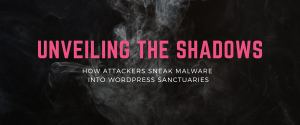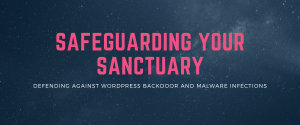In the vast realm of the internet, WordPress stands as a stronghold for countless websites. Its user-friendly interface, customizable themes, and extensive plugin library have made it the go-to choice for individuals and businesses alike. However, this popularity also attracts the attention of malicious actors seeking to exploit vulnerabilities. One prevalent threat that website owners must be vigilant against is the infiltration of backdoors and malware.
The Stealthy Culprits: Backdoors
Backdoors are covert passages into a system that allow unauthorized access. In the context of WordPress, these insidious entries are often created by attackers to maintain control over a website without the owner’s knowledge. The danger lies in their ability to persist undetected, enabling hackers to wreak havoc over an extended period.
One common method employed by cybercriminals is exploiting outdated themes or plugins. As the WordPress core regularly receives security updates, neglecting the maintenance of additional components can create vulnerabilities. Hackers capitalize on these weaknesses to plant backdoors discreetly, making it crucial for website owners to stay on top of updates.
The Silent Invaders: Malware
Malware, short for malicious software, encompasses a broad category of harmful programs designed to disrupt, damage, or gain unauthorized access to computer systems. In the WordPress ecosystem, malware can take various forms, from Trojans that disguise themselves as legitimate plugins to scripts that inject malicious code into a website’s files.
Common entry points for malware include compromised plugins or themes, weak passwords, and unsecured hosting environments. Regularly auditing your website’s security and employing robust authentication measures can significantly reduce the risk of malware infections.
The Arsenal of Defense: Best Practices
- Regular Updates: Keep your WordPress core, themes, and plugins up to date. Developers often release security patches in response to emerging threats, and updating promptly helps fortify your website against potential backdoors.
- Secure Passwords: Utilize strong, unique passwords for your WordPress admin, database, and hosting accounts. Avoid default usernames and consider implementing two-factor authentication for an added layer of defense.
- Plugin Vigilance: Choose reputable plugins from trusted sources. Verify the plugin’s compatibility with your WordPress version, read reviews, and monitor for updates. Remove any unused plugins to minimize potential vulnerabilities.
- Regular Backups: Schedule automated backups of your website’s data and files. In the event of a successful attack, having a recent backup ensures that you can swiftly restore your website to a secure state.
- Security Plugins: Implement security plugins specifically designed to detect and prevent backdoors and malware. These tools can conduct regular scans, monitor file changes, and provide real-time protection.
- Monitoring and Auditing: Keep a watchful eye on your website’s traffic and user activity. Unusual spikes or suspicious behavior may indicate a security breach. Regularly audit your website’s files and database for any unauthorized modifications.
Conclusion
In the ever-evolving landscape of cybersecurity, the battle against backdoors and malware is ongoing. By adopting a proactive stance and adhering to best practices, WordPress website owners can fortify their digital fortresses against potential infiltrators. Remember, safeguarding your online presence is not a one-time effort but a continuous commitment to the security of your digital domain. Stay vigilant, stay secure.
Book a FREE security audit of your WordPress website today with a member of our expert team, we’ll be able to advise best practise and help identify any vulnerabilities your site may have.
If you feel your website is already under attack, hacked or suffering from Malware, we can also help with a professional and guaranteed cleanse & secure service. Get in touch today to find out more!
To continue reading this 3 part mini series, click here for part 2.















